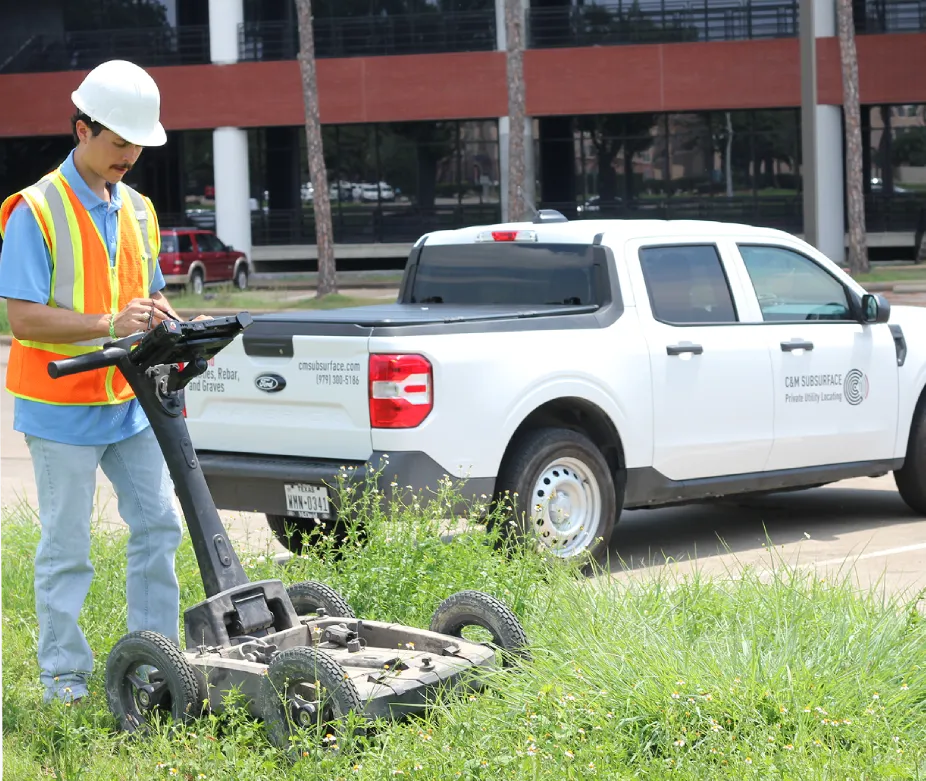C&M Subsurface delivers reliable utility locating, concrete scanning, and GPR services across Houston and the surrounding area.


At C&M Subsurface, we provide a full range of subsurface imaging and utility locating solutions designed to improve safety, accuracy, and efficiency on every project. From concrete scanning to cemetery mapping, our services are tailored to meet the unique needs of clients across houston, Texas.
Our Utility Locating services in Houston, TX deliver accurate, non-invasive mapping of underground utilities to keep your project safe and on schedule. Using advanced GPR, electromagnetic locators, and field expertise, we identify electrical conduits, gas tractors and property owners avoid costly damage and delays.
Our Utility Locating services in Houston, TX deliver accurate, non-invasive mapping of underground utilities to keep your project safe and on schedule. Using advanced GPR, electromagnetic locators, and field expertise, we identify electrical conduits, gas tractors and property owners avoid costly damage and delays.
Our Utility Locating services in Houston, TX deliver accurate, non-invasive mapping of underground utilities to keep your project safe and on schedule. Using advanced GPR, electromagnetic locators, and field expertise, we identify electrical conduits, gas tractors and property owners avoid costly damage and delays.
Our Utility Locating services in Houston, TX deliver accurate, non-invasive mapping of underground utilities to keep your project safe and on schedule. Using advanced GPR, electromagnetic locators, and field expertise, we identify electrical conduits, gas tractors and property owners avoid costly damage and delays.
Get a fast, accurate quote tailored to your project—so you can plan with confidence from the start.
Hiring a certified Ground Penetrating Radar (GPR) specialist gives you accurate, non-invasive subsurface data that prevents costly mistakes, delays, and safety risks. Our experts deliver real-time results you can trust—so your project stays safe, efficient, and on schedule.
| Mon-Fri | 9am – 5pm |
| Sat | 10am – 2pm |
| Sun | Closed |
Our projects span industries and cities, proving that no matter the challenge, we deliver clarity beneath the surface.
Beneath every successful project is a foundation of accuracy and safety. At C&M Subsurface, that’s exactly what we provide.


Lorem ipsum dolor sit amet, consectetur adipiscing elit, sed do eiusmo.

Lorem ipsum dolor sit amet, consectetur adipiscing elit, sed do eiusmo.

Lorem ipsum dolor sit amet, consectetur adipiscing elit, sed do eiusmo.

Lorem ipsum dolor sit amet, consectetur adipiscing elit, sed do eiusmo.

Lorem ipsum dolor sit amet, consectetur adipiscing elit, sed do eiusmo.
Ground Penetrating Radar (GPR) is a safe, non-invasive technology that uses high-frequency radar waves to create images of what lies beneath the surface. By sending radar pulses into the ground or through concrete, GPR can detect and map hidden features such as rebar, post-tension cables, conduits, voids, and underground utilities. Unlike destructive methods like drilling or coring, GPR provides accurate subsurface data without causing damage, making it an essential tool for construction, engineering, archaeological, and utility projects where safety, precision, and efficiency are critical.
Ground Penetrating Radar (GPR) is a safe, non-invasive technology that uses high-frequency radar waves to create images of what lies beneath the surface. By sending radar pulses into the ground or through concrete, GPR can detect and map hidden features such as rebar, post-tension cables, conduits, voids, and underground utilities. Unlike destructive methods like drilling or coring, GPR provides accurate subsurface data without causing damage, making it an essential tool for construction, engineering, archaeological, and utility projects where safety, precision, and efficiency are critical.
Ground Penetrating Radar (GPR) is a safe, non-invasive technology that uses high-frequency radar waves to create images of what lies beneath the surface. By sending radar pulses into the ground or through concrete, GPR can detect and map hidden features such as rebar, post-tension cables, conduits, voids, and underground utilities. Unlike destructive methods like drilling or coring, GPR provides accurate subsurface data without causing damage, making it an essential tool for construction, engineering, archaeological, and utility projects where safety, precision, and efficiency are critical.
Ground Penetrating Radar (GPR) is a safe, non-invasive technology that uses high-frequency radar waves to create images of what lies beneath the surface. By sending radar pulses into the ground or through concrete, GPR can detect and map hidden features such as rebar, post-tension cables, conduits, voids, and underground utilities. Unlike destructive methods like drilling or coring, GPR provides accurate subsurface data without causing damage, making it an essential tool for construction, engineering, archaeological, and utility projects where safety, precision, and efficiency are critical.
Ground Penetrating Radar (GPR) is a safe, non-invasive technology that uses high-frequency radar waves to create images of what lies beneath the surface. By sending radar pulses into the ground or through concrete, GPR can detect and map hidden features such as rebar, post-tension cables, conduits, voids, and underground utilities. Unlike destructive methods like drilling or coring, GPR provides accurate subsurface data without causing damage, making it an essential tool for construction, engineering, archaeological, and utility projects where safety, precision, and efficiency are critical.
Ground Penetrating Radar (GPR) is a safe, non-invasive technology that uses high-frequency radar waves to create images of what lies beneath the surface. By sending radar pulses into the ground or through concrete, GPR can detect and map hidden features such as rebar, post-tension cables, conduits, voids, and underground utilities. Unlike destructive methods like drilling or coring, GPR provides accurate subsurface data without causing damage, making it an essential tool for construction, engineering, archaeological, and utility projects where safety, precision, and efficiency are critical.